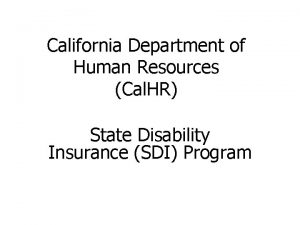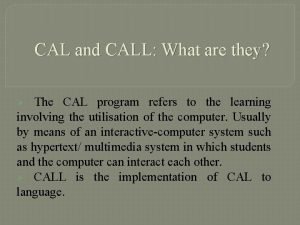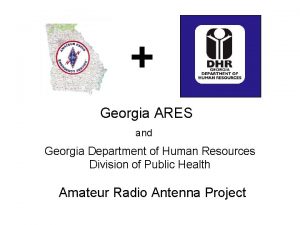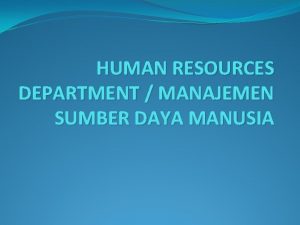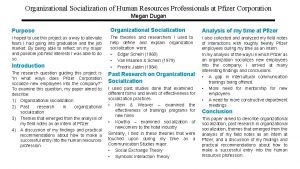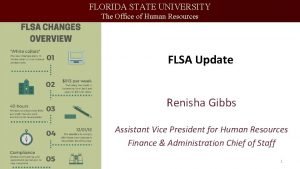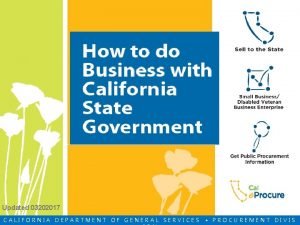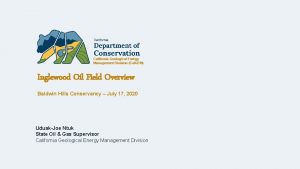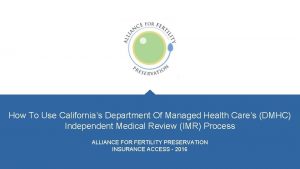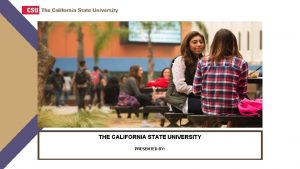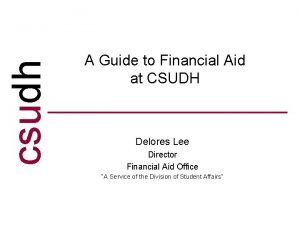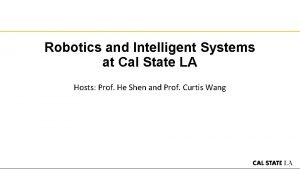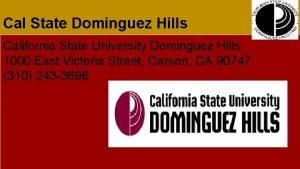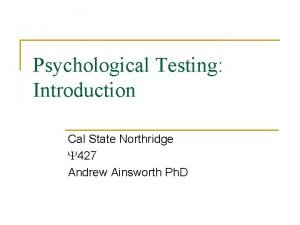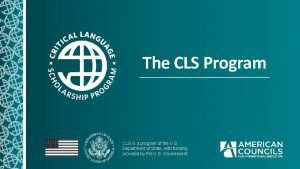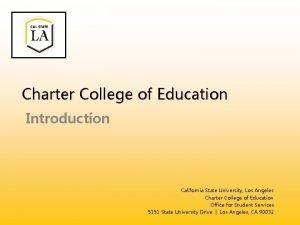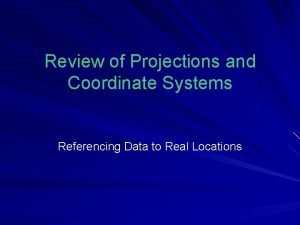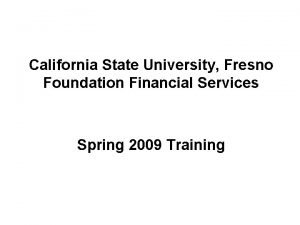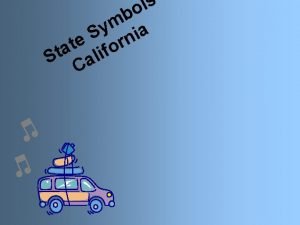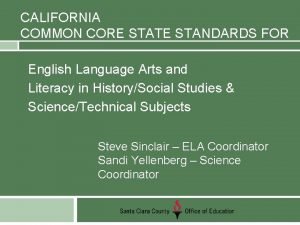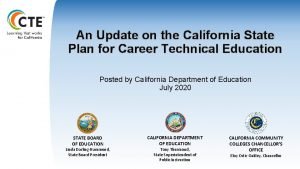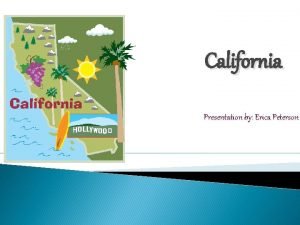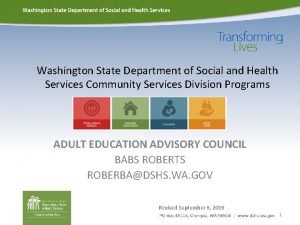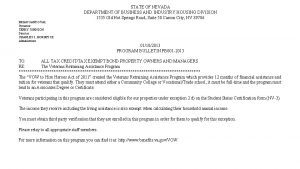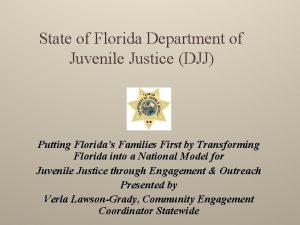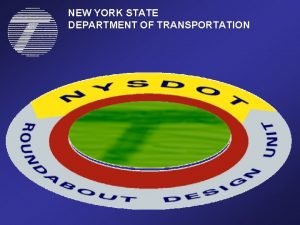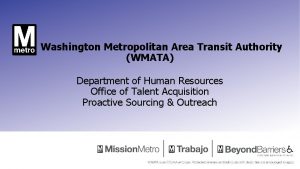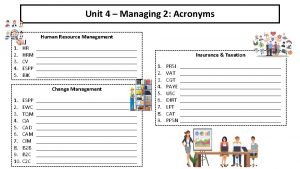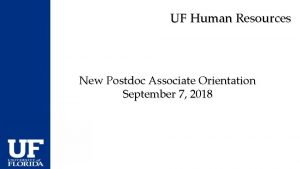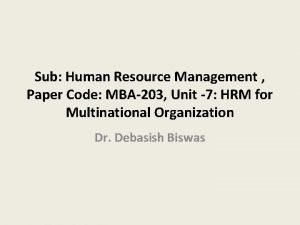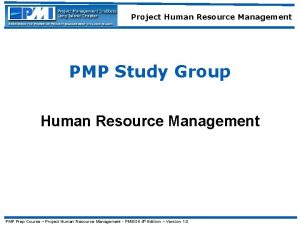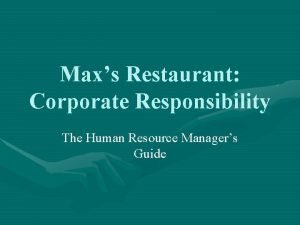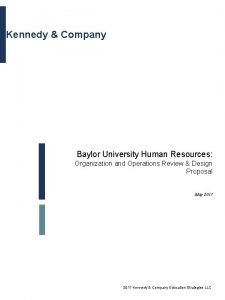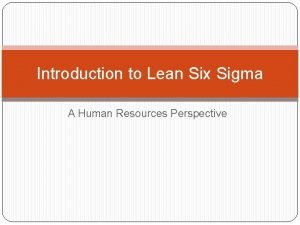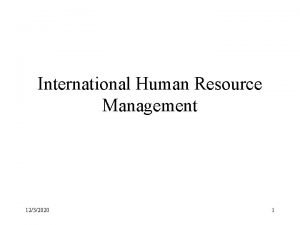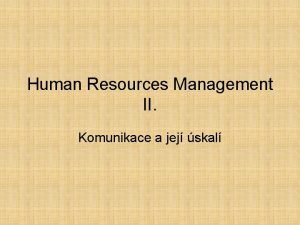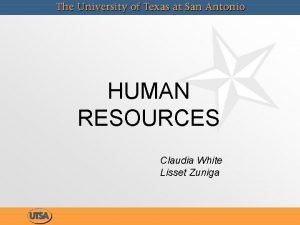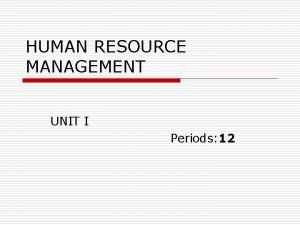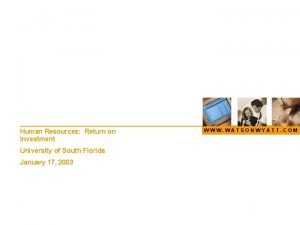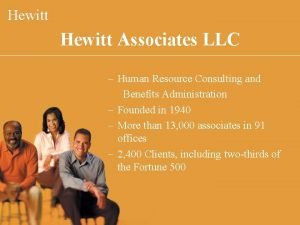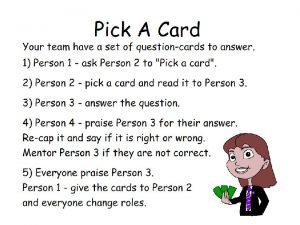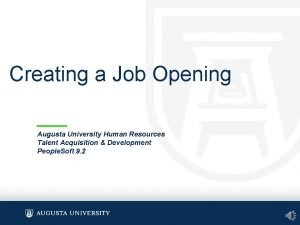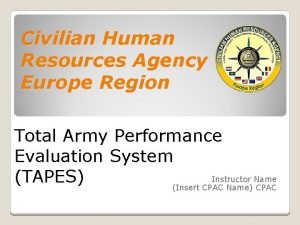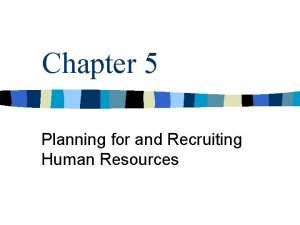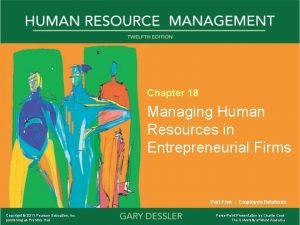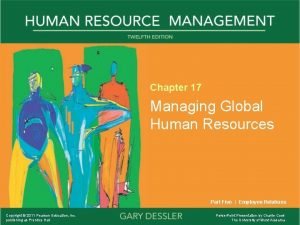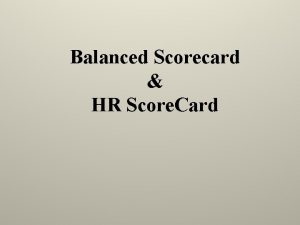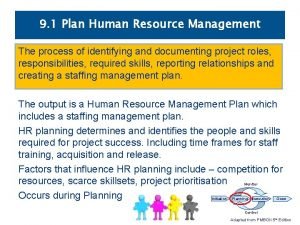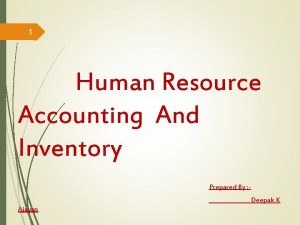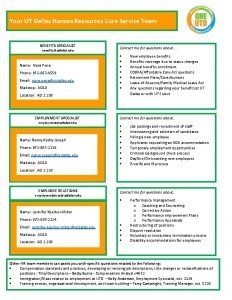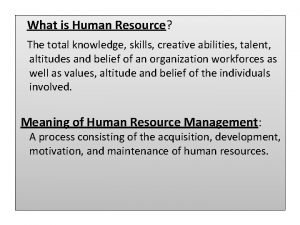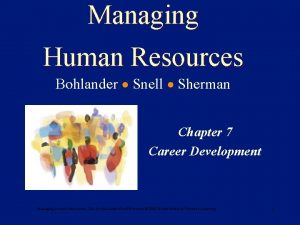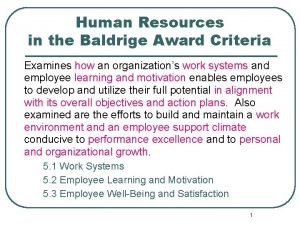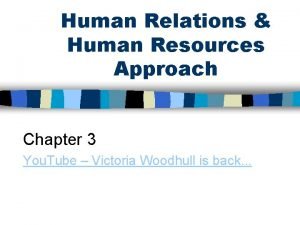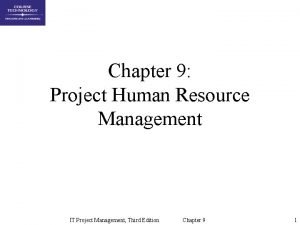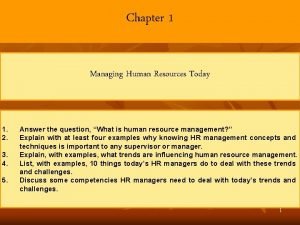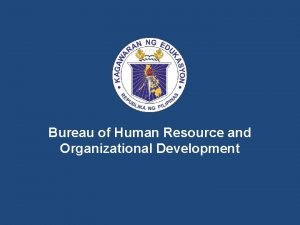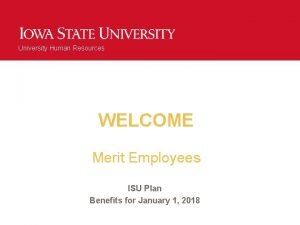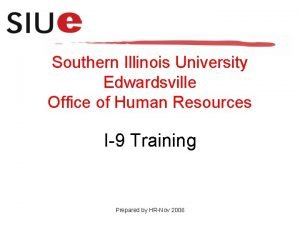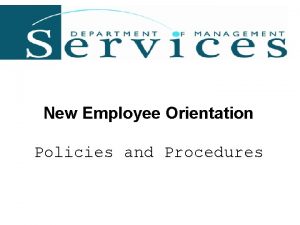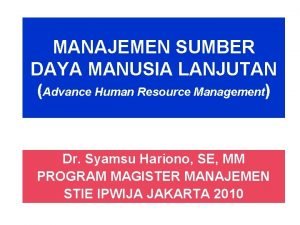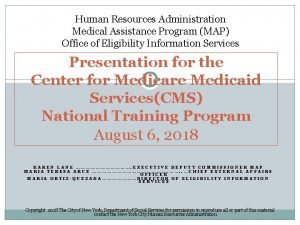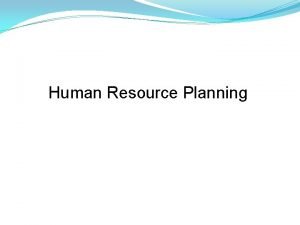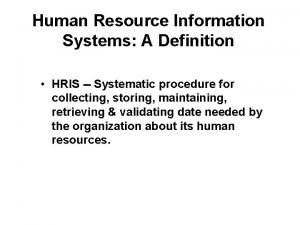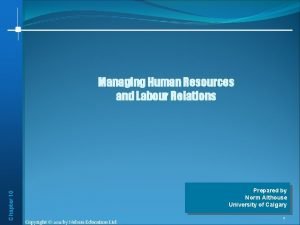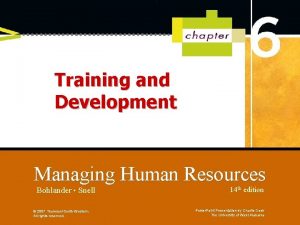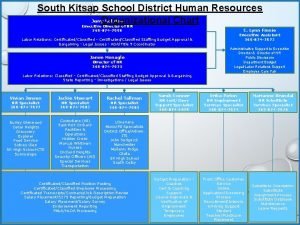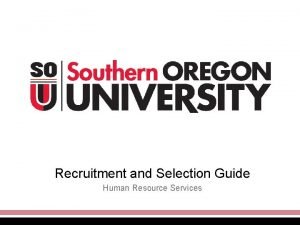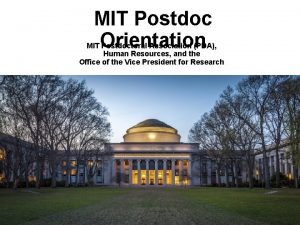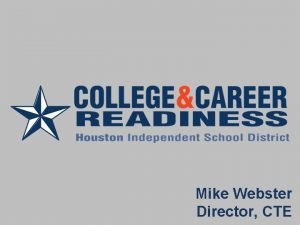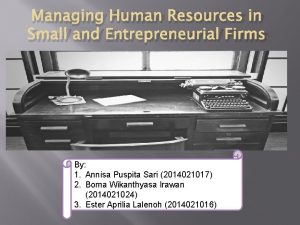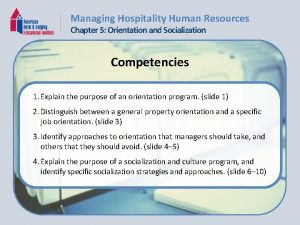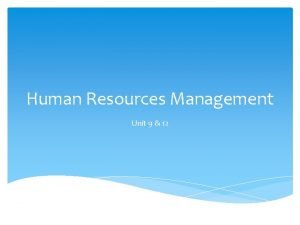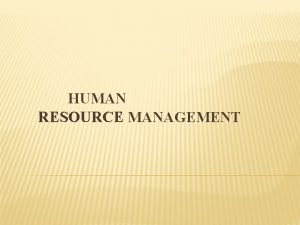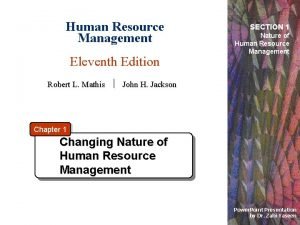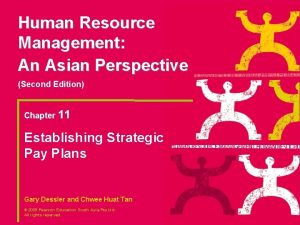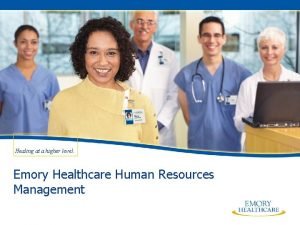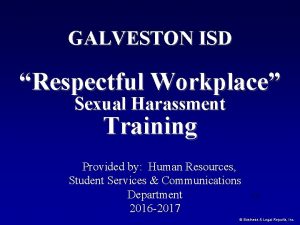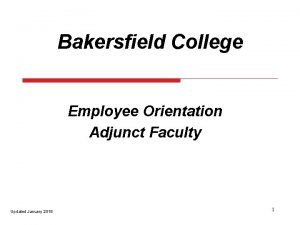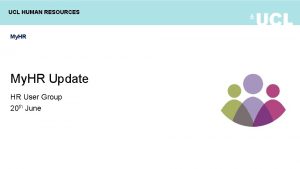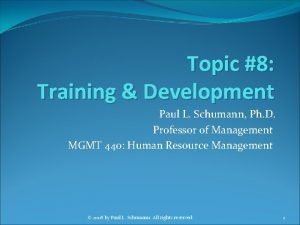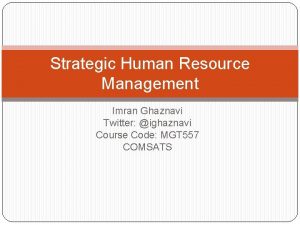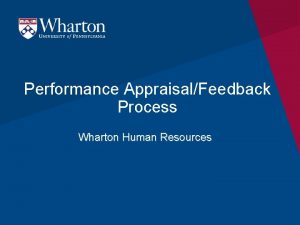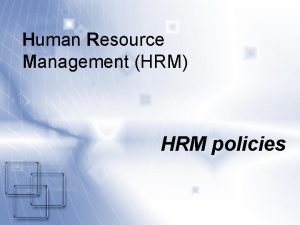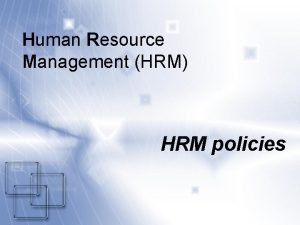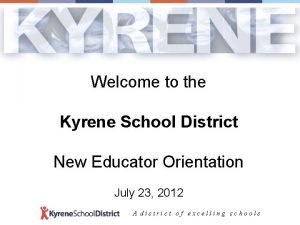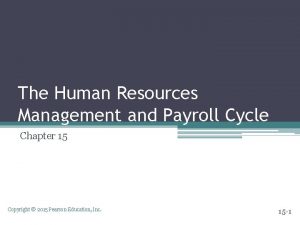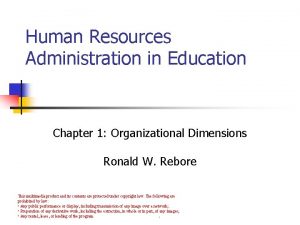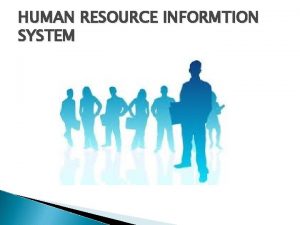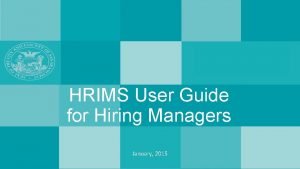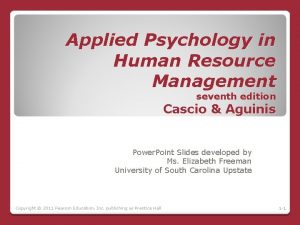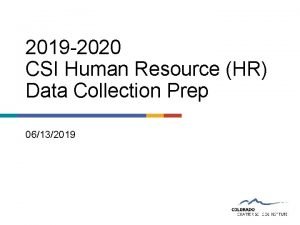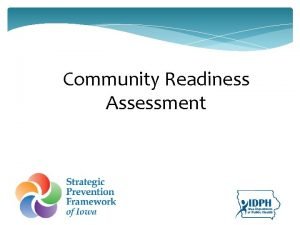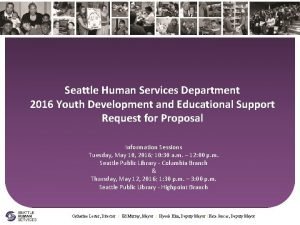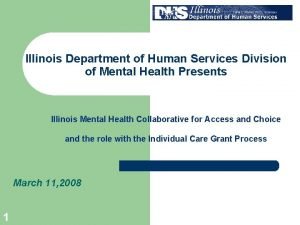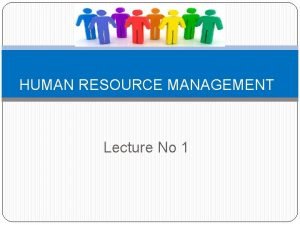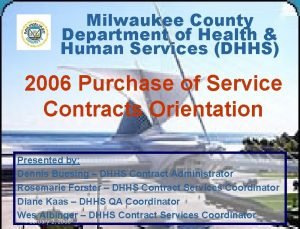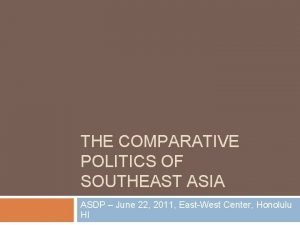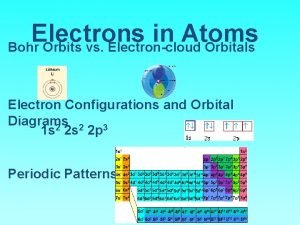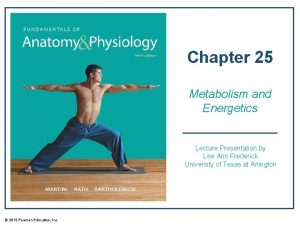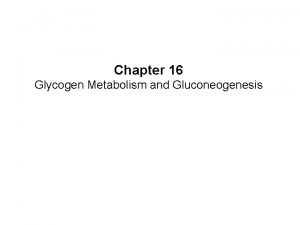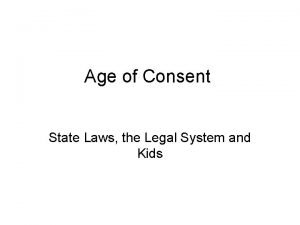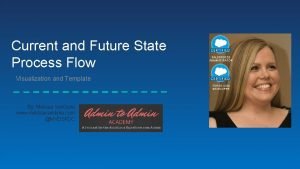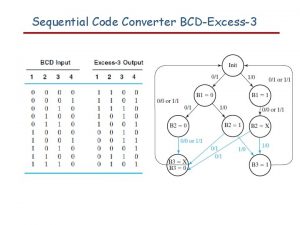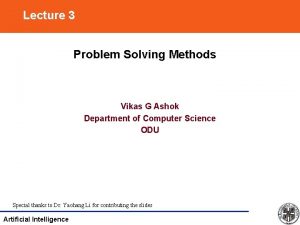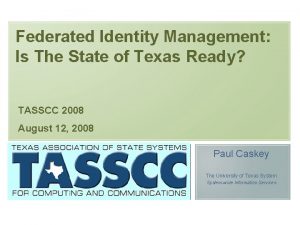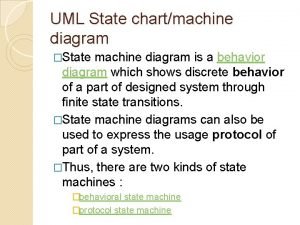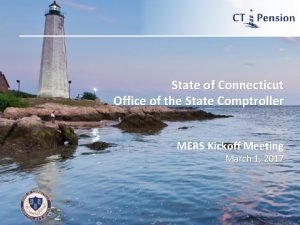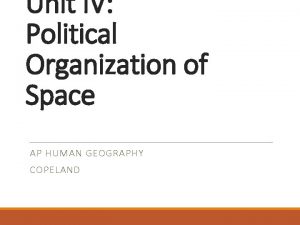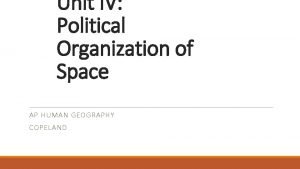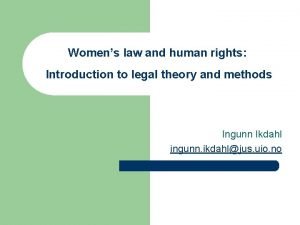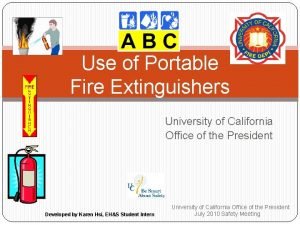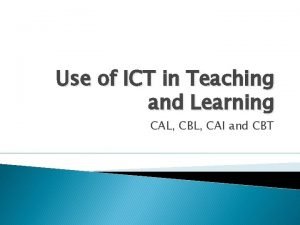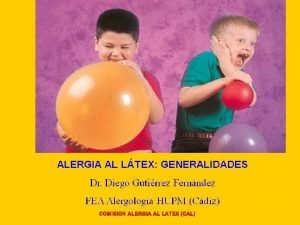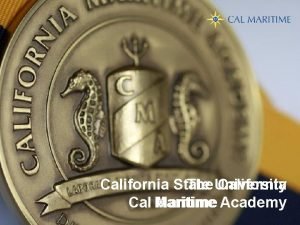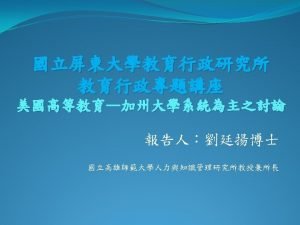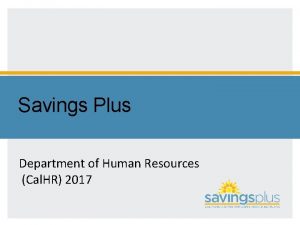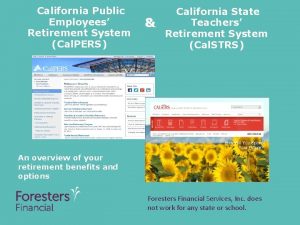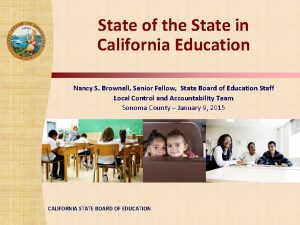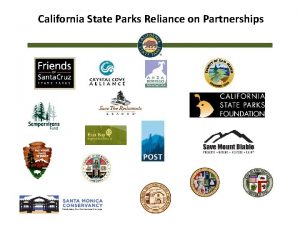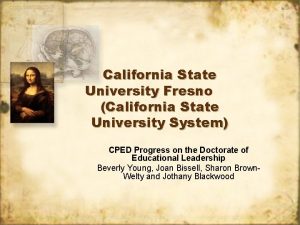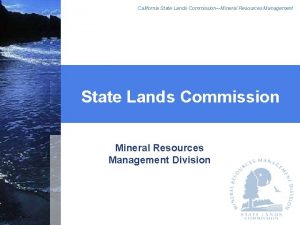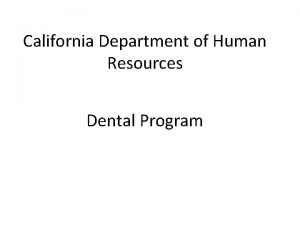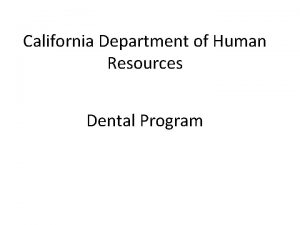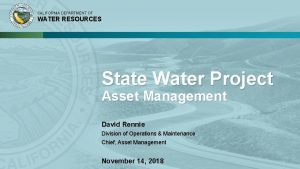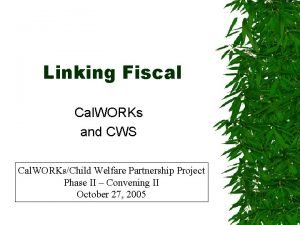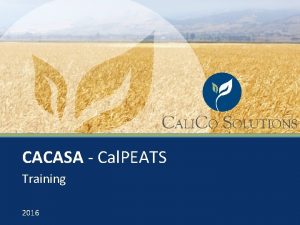California Department of Human Resources Cal HR State


























































































































































































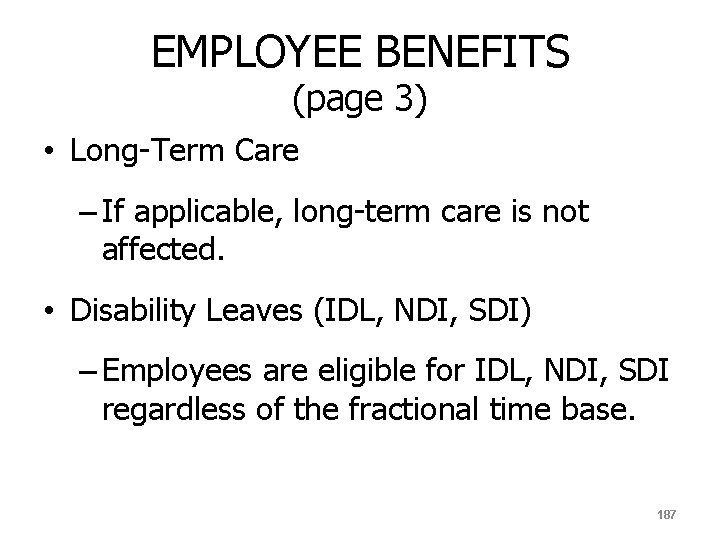
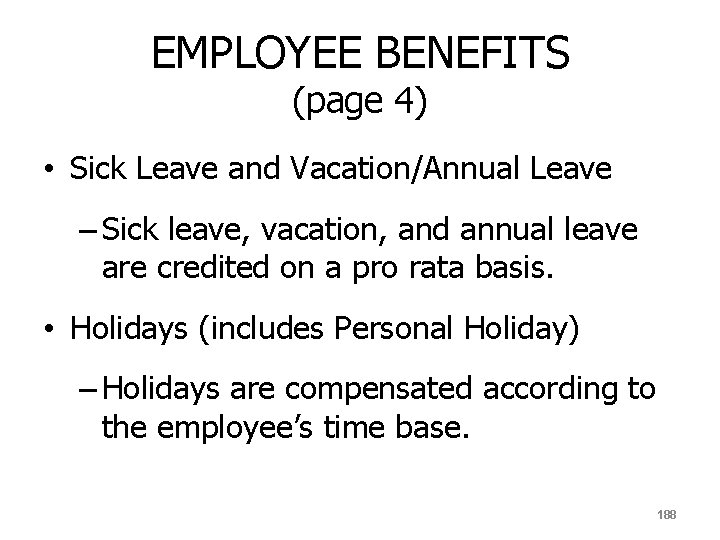
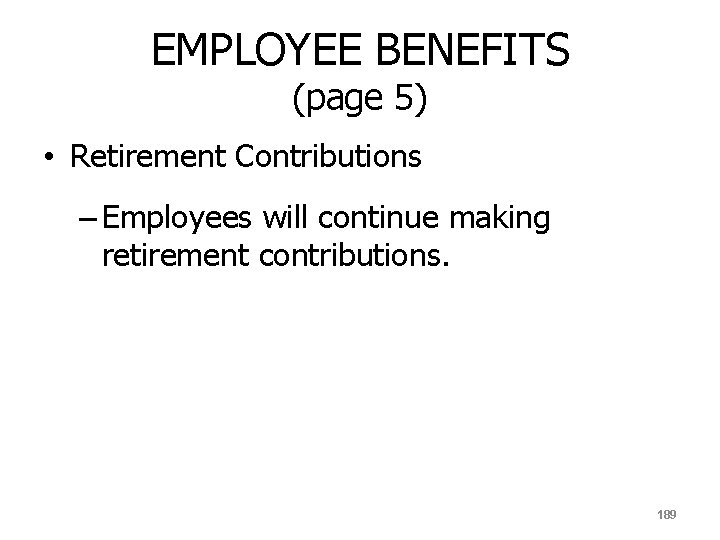
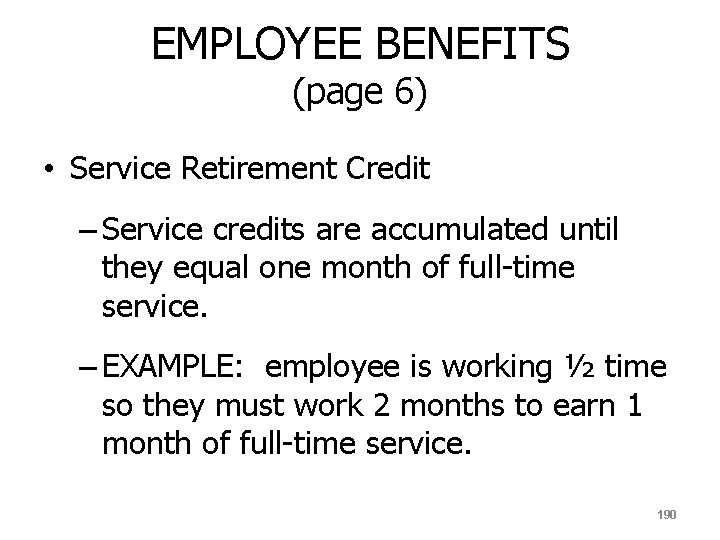
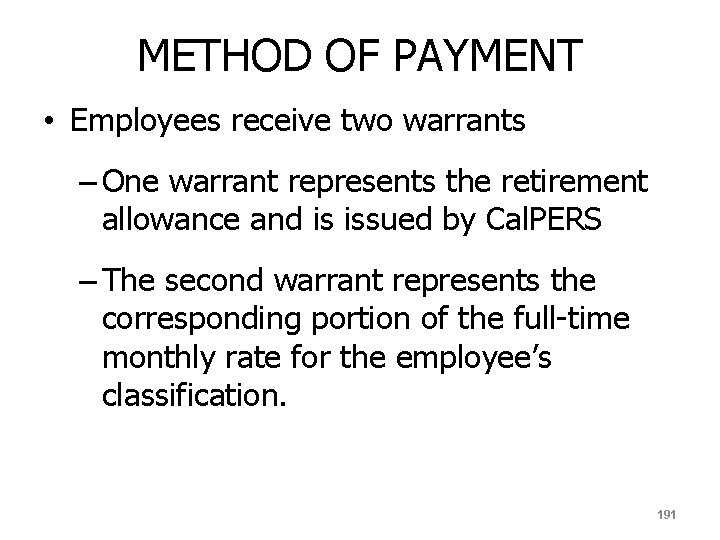
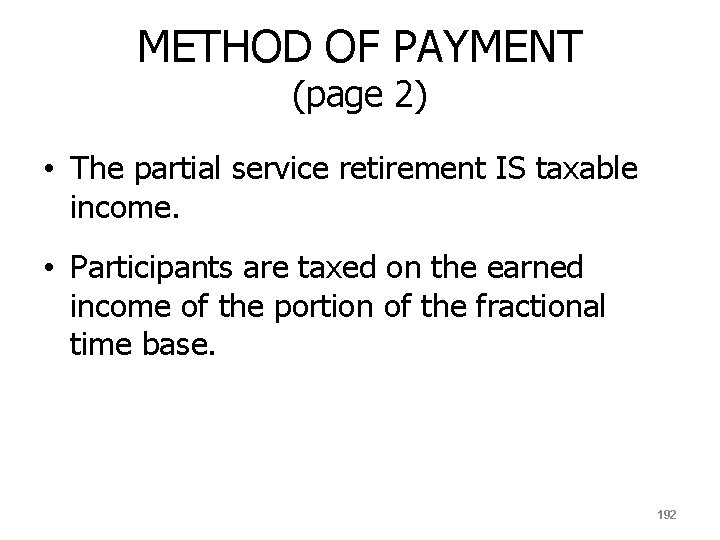

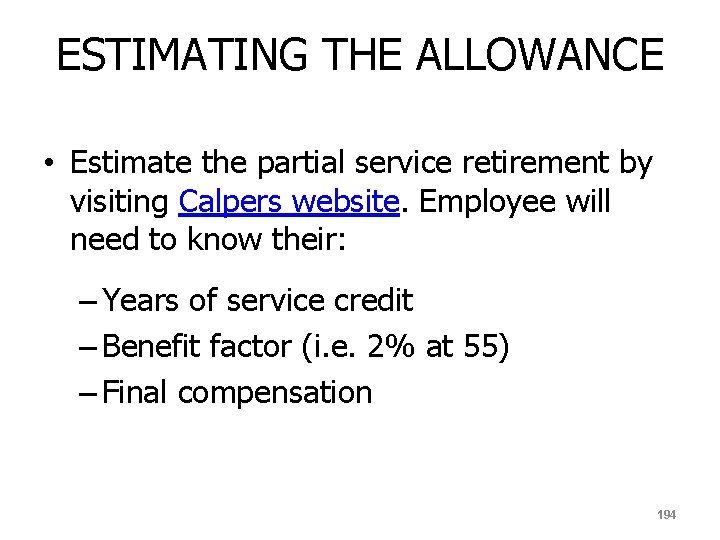
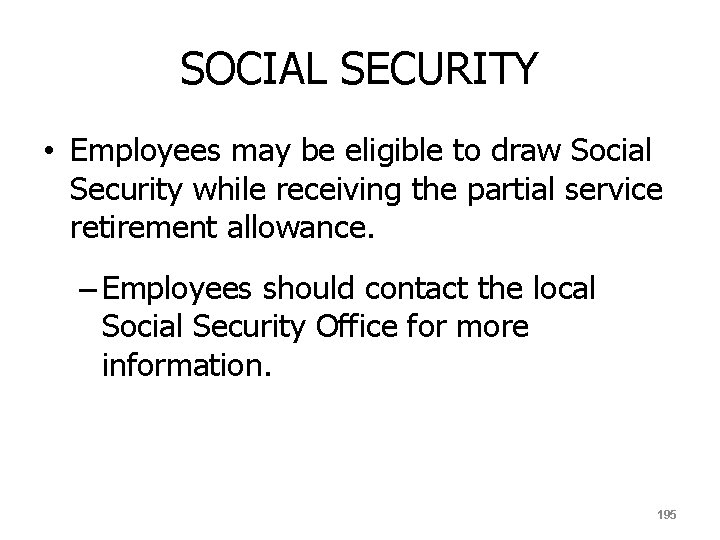

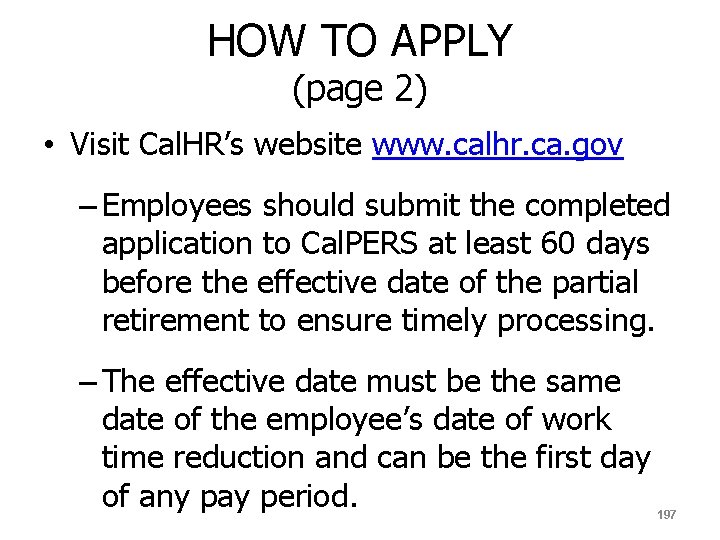
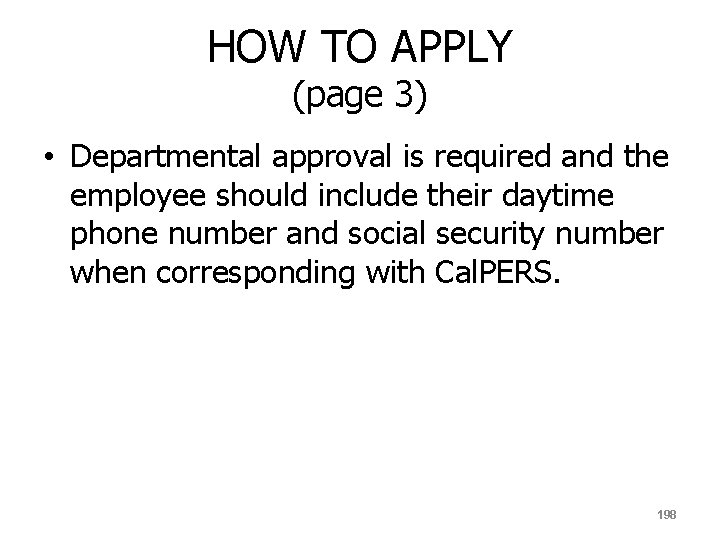
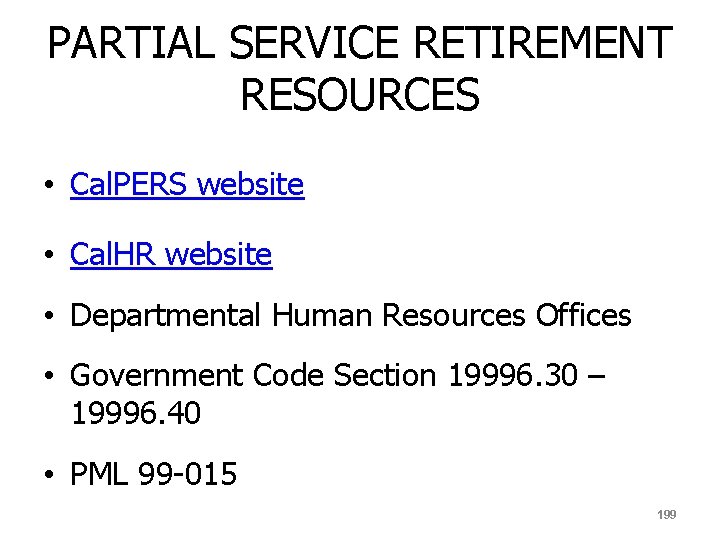

- Slides: 200

California Department of Human Resources (Cal. HR) State Disability Insurance (SDI) Program

COVERED EMPLOYEES • Rank and File Employees Only • Bargaining Units – 1, 3, 4, 11, 14, 15, 17, 20, and 21 (SEIU) – EXCEPTION: Seasonal clerks in BU 4 are not eligible for SDI. Article 18. 3. H. 6 of the contract. 2

CALHR’s RESPONSIBILITIES • Assure compliance with the MOU provisions. • Provide interpretation of policies and procedures. • Implement changes and updates that arise through bargaining negotiations. • Consultation as needed. 3

CALHR’s RESPONSIBILITIES (page 2) Notes: • PML 2006 -042 is an excellent guide. • Contract negotiated in 2010 added “current state employees who transfer into a SEIU bargaining unit who are eligible for ENDI and NDI benefits prior to transfer shall be entitled to retain their ENDI and NDI eligibility for 6 months. ” Article 9. 17. C of the contract. 4

CALHR’s RESPONSIBILITIES (page 3) • When sending the 674 D to SCO, note ENDI/NDI eligibility in item 11 so SCO does not return the form to you saying the employee is not eligible for benefits. 5

CALHR’s RESPONSIBILITIES (page 4) • When determining eligibility, remember to look at more than the employees classification, always look at the employee. 6

CALHR’s RESPONSIBILITIES (page 5) Example: • CONFIDENTIAL employee’s may appear to be in a SEIU bargaining unit but because they are confidential they are not covered by the bargaining unit and are eligible for NDI. Make sure you give the employee the correct disability information. 7

EDD’s RESPONSIBILITIES • Administers the DI/PFL Programs • Employment Development Department website – For information on how to file a claim and to get forms, go to their website. – Employees also have the option to apply online. 8

EMPLOYER RESPONSIBILITIES • Post Notice to Employees, DE 1857 A – Notice lists DI/PFL and includes EDD contact info. If you don’t have this notice you can get it from EDD’s website. 9

EMPLOYER RESPONSIBILITIES (page 2) • Provide employees with an options letter/check list – Refer to attachment D and E in PML 2006 -042. (dept. may modify to meet their needs) 10

EMPLOYER RESPONSIBILITIES (page 3) • Return DE 2503 form to EDD – The form is sent out by EDD when an employee files a claim. Complete quickly and return. 11

EMPLOYER RESPONSIBILITIES (page 4) • Managers, Supervisors and Employees must communicate with HR staff – This will eliminate any confusion for all. Everyone needs to communicate to ensure there are no overpayments. 12

EMPLOYEE RESPONSIBILITIES • Request a leave of absence. – Employee contacts their department’s Human Resources (HR) office and their immediate supervisor or manager. 13

EMPLOYEE RESPONSIBILITIES (page 2) • Notify their HR office if they elect to supplement. – SEIU MOU 9. 17– employee or representative must contact HR within 1 week of being disabled. 14

EMPLOYEE RESPONSIBILITIES (page 3) – Employee must request the supplementation within the first 7 days of their LOA; – Employee may supplement up to 40 hrs. per month, does not include the 7 days waiting period. 15

EMPLOYEE RESPONSIBILITIES (page 4) • Provide HR copies of SDI pay statements. – In order for HR to post supplementation credits the employee must provide copies of their SDI pay statements per SEIU MOU 9. 17. – HR must have this to eliminate any overpayments. 16

EMPLOYEE RESPONSIBILITIES (page 5) • Provide documentation of any changes in their health status or SDI benefits. – If employee is released to return to work part-time or employee is no longer receiving SDI benefits. 17

HEALTH INSURANCE COVERAGE (Health, Dental, and Vision) • 26 weeks of benefit continuation – Benefits are covered up to 26 weeks per contract. Although, SDI itself may be up to 52 weeks. 18

HEALTH INSURANCE COVERAGE (Health, Dental, and Vision) (page 2) – If SDI is longer than 26 weeks and the employee is supplementing, benefits may be covered if the supplementation amount is enough money to cover the cost. – Otherwise, offer the employee Direct Pay. 19

HEALTH INSURANCE COVERAGE (Health, Dental, and Vision) (page 3) • Accounts Receivables are set up for the employee’s portion of the premiums upon the employee’s return to work. – Method of collection is by mutual agreement between the employee and employer. 20

HEALTH INSURANCE COVERAGE (Health, Dental, and Vision) (page 4) • Overpayments may be satisfied through payroll deduction, agency collection or the use of leave credits (excluding sick leave). Notes: – PML 2006 -042 – SCO Payroll Letter 06 -025 – Article 9. 17 of the SEIU MOU 21

LEAVE OF ABSENCE REQUIREMENTS • An employee is required to obtain an approved leave of absence. – The department MUST grant an unpaid leave of absence when SDI is approved. – The leave of absence is the mechanism through which we are able to implement SDI. 22

LEAVE OF ABSENCE REQUIREMENTS (page 2) – Being eligible for FMLA/CFRA will not affect whether a leave of absence is approved or not. – If the qualifying injury or illness continues beyond the expiration date of the SDI benefits, the leave of absence may be extended. 23

LEAVE OF ABSENCE REQUIREMENTS (page 3) • A leave may be granted due to illness, injury, pregnancy, or a need to bond or care for a newborn or adopted child. • A leave may also be granted due to a family illness or injury. 24

LEAVE OF ABSENCE REQUIREMENTS (page 4) Notes: • Employee must contact their department’s Human Resources (HR) office and their immediate supervisor or manager. • PML 2006 -042 has a sample of a leave of absence request for SDI. 25

SUPPLEMENTING SDI BENEFITS WITH LEAVE CREDITS • An employee may use leave credits to satisfy the 7 day waiting period. • 40 hour maximum leave credit supplementation (does not include the 7 day waiting period). 26

SUPPLEMENTING SDI BENEFITS WITH LEAVE CREDITS (page 2) • An employee supplementing and receiving SDI benefits shall not exceed the salary they would have received had they been working. 27

SUPPLEMENTING SDI BENEFITS WITH LEAVE CREDITS (page 3) • Must notify the employer within the first 7 days of the leave per MOU Article 9. 17. • Amount of leave must remain the same throughout the leave of absence. – The employee elects to use 20 hrs. and after 3 months only has 10 hrs. then the supplementation would be reduced. 28

SUPPLEMENTING SDI BENEFITS WITH LEAVE CREDITS (page 4) • Must provide HR office with copies of the pay statement – Employees receive debit cards and will receive a pay statement (DE 2500 E) showing the information previously shown on the check stub. They can also print electronically by logging into their profile on EDD’s website. 29

LEAVE USED TO SUPPLEMENT • Annual Leave/Vacation Leave • Compensating Time Off (CTO) • Furlough • Holiday Credit • Personal Leave (PLP or VPLP) 30

LEAVE USED TO SUPPLEMENT (page 2) • Professional Development Days (PDD) • Sick Leave – Sick leave is okay during DI portion of SDI but is in conflict with SDI benefit. 31

SDI SCENARIO 1 Question 1: The employee is on SDI for 30 weeks and has elected to supplement 40 hours per month. Will the health benefit coverage continue beyond the 26 weeks? 32

SDI SCENARIO 1 (page 2) Answer 1: Yes. The health benefit’s will be covered for the remaining 4 weeks by the use of leave credits. The supplementation will cover the additional weeks. If the employee has enough leave to supplement for 52 weeks then benefit coverage will be continued for 52 weeks. 33

SDI SCENARIO 2 Question 2: The employee is out on SDI for 9 months and elected to supplement 30 hours a month for 6 months. Will the health benefits coverage continue beyond the 26 weeks? 34

SDI SCENARIO 2 (page 2) Answer 2: No. The department must notify the employee of their option to elect direct pay. The employee is only entitled to 26 weeks of benefit continuation during SDI unless they are supplementing. If the supplementation goes beyond the 26 weeks and is enough to cover the employee share of the premiums then benefits will be continued. 35

SDI SCENARIO 3 Question 3: How will departments know when the SDI benefits end, since EDD does not provide departments with the end date of the employee’s SDI? 36

SDI SCENARIO 3 (page 2) Answer 1: It is the responsibility of the employee to notify their HR department with any changes in their SDI benefits. 37

SDI SCENARIO 3 (page 3) Answer 2: The employee’s bargaining unit agreement in Article 9. 17 states the employee provide copies of their pay statements. If the employee is no longer providing HR with SDI pay statements the department may discontinue the health benefits as well as supplementation. 38

SDI SCENARIO 4 Question 4: Can an employee supplement while on Paid Family Leave (PFL)? 39

SDI SCENARIO 4 (page 2) Answer 1: Yes. An employee may elect to supplement while on DI or PFL. Answer 2: PFL is a component of SDI and employees may supplement. 40

SDI SCENARIO 5 Question 5: How many leave credits can a part-time or intermittent employee use for supplementation? Answer: An employee may supplement up to 40 hours of leave credits per month. 41

SDI SCENARIO 6 Question 6: Must an employee be eligible for FMLA to receive the 26 weeks of health benefits? Answer 1: No. An employee does not have to be FMLA qualified to receive health benefits. 42

SDI SCENARIO 6 (page 2) Answer 2: When SDI was first introduced employees had to be eligible for FMLA/CFRA in order to have their benefits continued and the continuation was only for 12 work weeks. Then the employee was offered direct pay. That was changed and as you know employees now receive up to 26 weeks of benefits during SDI. 43

SDI SCENARIO 7 Question 7: When an employee elects to supplement their SDI is there a specific leave that must be used first? 44

SDI SCENARIO 7 (page 2) Answer 1: No. The type of leave credits used is determined by the employee. Answer 2: Sick leave may only be used for a sick leave qualifying reason. Sick leave for baby bonding is not appropriate unless the baby is ill or has a medical appointment. 45

SDI SCENARIO 8 Question 8: When an employee transfers from an excluded position to a rank and file position, which benefit will cover the employee? 46

SDI SCENARIO 8 (page 2) Answer 1: If the employee was eligible for ENDI and NDI prior to transfer they are entitled to retain their ENDI/NDI eligibility for 6 months. See Article 9. 17 of the contract. 47

SDI SCENARIO 8 (page 3) Answer 2: The employee may apply for NDI and SDI, and EDD will determine the employee’s eligibility for benefits under the appropriate programs. Case by case basis. 48

SDI SCENARIO 9 Question 9: When an employee who has paid into SDI, transfers from a rank and file position to an excluded position, is the employee now eligible for both SDI and NDI? Answer 1: EDD is responsible for determining the employee’s eligibility for both SDI and NDI benefits. 49

SDI SCENARIO 9 (page 2) Answer 2: Even though EDD may approve both, the employee only receives NDI benefits from the employer. This means the employee may not supplement up to 40 hours a month. Supplementation of NDI is only when the employee is on annual leave and has requested to supplement to receive 75 or 100% of their pay. 50

SDI SCENARIO 9 (page 3) Answer 3: If an employee is approved for PFL through EDD the department is only responsible for allowing the employee to take the time off. The employee is not entitled to supplement their PFL with leave credits as they are not eligible for SDI through YOU the employer. 51

SDI SCENARIO 10 Question 10: When using paid leave while receiving SDI benefits, how will the employee receive payments? 52

SDI SCENARIO 10 (page 2) Answer 1: The employer will pay the requested amount of leave credits (waiting period hours and up to 40 hours maximum for supplementation). 53

SDI SCENARIO 10 (page 3) Answer 2: The employer will issue a check via the PIP system, if the employee requested to be paid for the waiting period or supplementation. EDD/SDI unit will determine the correct benefit payment for SDI and pay the employee. 54

SDI RESOURCES • EDD Website www. edd. ca. gov • Cal. HR Website www. calhr. ca. gov • MOUs • Cal. HR PMLs 55

FAMILY AND MEDICAL LEAVE ACT OF 1993 AND CALIFORNIA FAMILY RIGHTS ACT 56

WHAT IS FMLA/CFRA • 12 work weeks of unpaid leave • 26 work weeks of unpaid leave for Military Caregiver Leave – Both FMLA and CFRA are job protected unpaid leaves which allow employees to take leave for up to 12 work weeks in a 12 month calendar year. 57

WHAT IS FMLA/CFRA (page 2) • Option to use leave credits to cover an absence – Even though FMLA and CFRA are unpaid leaves, both laws state the employee may chose to use leave credits or the employer may require the use of leave credits. 58

WHAT IS FMLA/CFRA (page 3) – However, the BU contracts state the employee has the option to use leave or not, or a combination of both. Thus during the FMLA period employees may break the continuity of dock. 59

WHAT IS FMLA/CFRA (page 4) • Job protection – When FMLA and CRA are in conflict, must give employee the better benefit (usually CFRA). • Continuation of Health, Dental, and Vision benefits 60

WHAT IS FMLA/CFRA (page 5) – If the employee chooses unpaid FMLA leave, benefits (health, dental, vision) must be maintained under the same provisions as if the employee had been continuously employed. – The employee is still responsible for their share of the premiums. 61

WHAT IS FMLA/CFRA (page 6) – During a paid leave the employee share of the premium is paid through payroll deduction, the method normally used during any paid leave. – During an unpaid leave the employee share of the premium is paid by the department and an accounts receivable is established. 62

WHAT IS FMLA/CFRA (page 7) – If the employee does not return to work for a reason other than the continuance of a serious health condition, the department may recover its share of the health premium. 63

HOW DO YOU DETERMINE IF THE EMPLOYEE IS ELIGIBLE? • In order to be eligible for FMLA/CFRA leave, an employee must work for a covered employer and: – Must have been employed by the employer for at least 12 months. 64

HOW DO YOU DETERMINE IF THE EMPLOYEE IS ELIGIBLE? (page 2) – Must have worked for at least 1, 250 hours during the 12 -month period immediately preceding the leave. This criteria is the same for Full-time, Parttime, and Intermittent employees. – Use the principles established under the Fair Labor Standards Act (FLSA) for determining compensable hours of work. (See 29 CFR part 785). 65

HOW DO YOU DETERMINE IF THE EMPLOYEE IS ELIGIBLE? (page 3) – The 1, 250 hours are actual hours worked, overtime, ATO, and military leave count as time worked. – For employees who were out on military leave you count the months and hours the employee would have worked towards their FMLA eligibility. 66

HOW DO YOU DETERMINE IF THE EMPLOYEE IS ELIGIBLE? (page 4) – Sick/vacation, other leaves, holidays, FMLA/CFRA, Jury Duty, do not count. – Union Paid Leave may count (case by case scenario). 67

HOW DO YOU DETERMINE IF THE EMPLOYEE IS ELIGIBLE? (page 5) – For employees in SEIU bargaining units you need to notify the union within 30 days when the employee is denied FMLA due to not meeting the 1, 250 hour requirement. MOU section 8. 16 I 68

WHAT TRIGGERS FMLA? • The employee’s own serious health condition • The serious health condition of an employee’s spouse, child, parent, or domestic partner (as defined in Family Code Section 297) 69

WHAT TRIGGERS FMLA? (page 2) • The birth of a child or the placement of a child with the employee for adoption or foster care. 70

WHAT TRIGGERS FMLA? (page 3) • Various Military leaves: Qualifying Exigency Leave and Military Caregiver Leave – At this time in-laws and siblings are not included. Exception would be siblings under the military caregiver leave as the sibling could be the next-of-kin. 71

SERIOUS HEALTH CONDITIONS • Chronic serious health conditions, such as asthma, diabetes and epilepsy. • Permanent conditions, such as Alzheimer’s or stroke. • Conditions that require multiple treatments, such as chemotherapy, radiation, and dialysis. • Severe morning sickness. 72

SERIOUS HEALTH CONDITIONS (page 2) • Ongoing treatment by a health care provider, such as physical therapy or severe arthritis. – These are just a few examples of serious health conditions. Whatever the condition is, the doctor must designate it as a serious health condition. 73

NOT SERIOUS HEALTH CONDITIONS • Common cold • Earache • Upset stomach • Headaches (other than migraines) • Routine dental treatment • Cosmetic treatments 74

EMPLOYER NOTICE REQUIREMENTS General Notice Must be posted explaining FMLA provisions and the procedures for filing a claim. It must be:

EMPLOYER NOTICE REQUIREMENTS (page 2) • Posted in a place accessible to all employees. • Electronic posting may be done when all employee have access to electronic info. 76

EMPLOYER NOTICE REQUIREMENTS (page 3) • New employees must be notified of their FMLA rights at the time of hire. • Prototypes are available at the Wage and Hour Division, of the Department of Industrial Relations. 77

EMPLOYER NOTICE REQUIREMENTS (page 4) • When an employee requests FMLA, notice them of their FMLA eligibility and their rights and responsibilities using Cal. HR form 752 – Notice of FMLA eligibility and Rights and Responsibilities. 78

EMPLOYER NOTICE REQUIREMENTS (page 5) • You have 5 business days to notice the employee of their eligibility or the reason why if they’re not eligible. • If the employee is eligible, inform and notify them if they are required to provide a medical certification and their rights to use paid leave. 79

EMPLOYER NOTICE REQUIREMENTS (page 6) • When FMLA is denied due to the lack of the employee working 1, 250 hours a copy of the written denial may also need to be sent to the union within 30 days. Check the specific bargaining unit contract. 80

EMPLOYER NOTICE REQUIREMENTS (page 7) • You also have 5 business days after receiving a satisfactory medical certificate to provide the employee a designation notice which designated the leave as FMLA -job protected. 81

EMPLOYER NOTICE REQUIREMENTS (page 8) • The notice also informs the employee of the amount of leave to be counted against the employee's FMLA leave entitlement. • The Designation Notice – Cal. HR 753 may be used or the department may customize their own. 82

EMPLOYER NOTICE REQUIREMENTS (page 9) • Notice of FMLA Eligibility and Rights and Responsibilities – Cal. HR 752 (DOL WH 381) form • Designation Notice – Cal. HR 753 (DOL WH -382) form 83

EMPLOYER NOTICE REQUIREMENTS (page 10) • When the leave is foreseeable – When the leave is foreseeable, a department may require the employee to provide at least a 30 day’s advance notice. 84

EMPLOYER NOTICE REQUIREMENTS (page 11) – If the employee does not ask for FMLA leave 30 days in advance, you may ask them to explain why 30 days’ notice was not possible. – You can’t deny it but you can ask them why the short notice. This will help you determine if the employee provided notice as soon as practicable. 85

EMPLOYER NOTICE REQUIREMENTS (page 12) • When the leave is not foreseeable – When leave is NOT foreseeable, then FMLA requires the notice to be provided as soon as practicable. 86

EMPLOYER NOTICE REQUIREMENTS (page 13) • EXAMPLE – I went to physical therapy yesterday and my appointment scheduled for the following month has been changed to next week. When I return to work I inform my supervisor that I now need leave next week instead of next month. I have provided notice of my need foreseeable leave as soon as practicable. 87

MEDICAL CERTIFICATIONS • Time to request medical certifications – You should request a medical certification at the time the employee gives notice for the need for FMLA or within 5 business days. (CALHR 752) 88

MEDICAL CERTIFICATIONS (page 2) • Incomplete and insufficient certifications defined – A certification is sufficient if it includes: • the date on which the serious health condition commenced. 89

MEDICAL CERTIFICATIONS (page 3) • Probable duration of the condition and; • A statement that due to the serious health condition, the employee is unable to perform one or more of the essential functions of their position. 90

MEDICAL CERTIFICATIONS (page 4) – If the medical certification is incomplete or insufficient you must state in writing what additional information is necessary to make the certification complete. 91

MEDICAL CERTIFICATIONS (page 5) – The rules also require you to allow the employee 7 calendar days to cure the deficiency. This is not a firm timeline and should be looked at on a case by case basis. – CANNOT ASK THE NATURE OF THE SERIOUS HEALTH CONDITION. 92

MEDICAL CERTIFICATIONS (page 6) • Who may contact the Health Care Provider? – The employee’s direct supervisor MAY NOT contact the health care provider.

MEDICAL CERTIFICATIONS (page 7) – The recent CFRA changes allow the personnel office to contact the health care provider for the limited purpose of authenticating the certification, nothing more.

MEDICAL CERTIFICATIONS (page 8) • Recertifying medical certifications – Employees are not required to recertify until the initial period of leave has elapsed. Or , there are changed circumstances or a reason to doubt the continuing of the leave. 95

MEDICAL CERTIFICATIONS (page 9) – For example: Certification says 3 days per month and now the employee is using 8 days per month. Dept. can request recertification. 96

SECOND AND THIRD OPINIONS • If the employer has a “good faith” objective reason to doubt the validity of the medical certification, the employer may require a second medical opinion. – The employer chooses the health care provider for the second opinion and also pays for the opinion. 97

SECOND AND THIRD OPINIONS (page 2) • If the first and second opinions conflict, then a third opinion may be requested. – If the first and second opinion conflict the employee and employer will choose a health care provider for the third opinion. The employer pays for the third opinion and the third opinion is final and binding. 98

WHAT IS INTERMITTENT LEAVE? • Separate periods of time • May include periods of leave such as an hour or more to several weeks – It may be taken intermittently or on a reduced leave schedule when medically necessary for own serious health condition. 99

WHAT IS INTERMITTENT LEAVE? (page 2) • WWG E excluded and represented employees: Intermittent partial days, only counts against FMLA because they do not use leave in less than whole days. 100

WHAT IS INTERMITTENT LEAVE? (page 3) Examples: • Intermittent partial days FMLA - Certification says the employee needs FMLA each month 3 to 4 days per month, 4 or 5 hours per day. This is intermittent leave. 101

WHAT IS INTERMITTENT LEAVE? (page 4) • If the employee works a partial day and leaves for an FMLA reason, the partial day of leave counts against the FMLA entitlement and the employee does not use leave credits to cover the partial day absence. 102

WHAT IS INTERMITTENT LEAVE? (page 5) • WWG E excluded and represented employees: Intermittent partial days, only counts against FMLA because they do not use leave in less than whole days. 103

WHAT IS INTERMITTENT LEAVE? (page 6) Examples: • WWG E set schedule FMLA – if the certification states the employee may work 4 hours per day from this date to this date, this is a set schedule. 104

WHAT IS INTERMITTENT LEAVE? (page 7) • For WWG E employees excluded from bargaining, the employee will use leave credits or dock for the remaining 4 hours of the day and the time absent counts against their FMLA entitlement. 105

WHAT IS INTERMITTENT LEAVE? (page 8) • In this same scenario, for WWG E represented employees you can only count the absent time against their FMLA entitlement as the contracts state they may not use leave in less than whole day increments. 106

WHAT IS INTERMITTENT LEAVE? (page 9) • Holidays are counted against FMLA when they fall within a weekly block of leave. When leave is taken in less than a full work week, then the holiday is not counted as FMLA. 107

RETURNING TO WORK • Reinstated to the same or equivalent job – An employee is entitled to be returned to the same position they were in when the leave started, or to an equivalent position with equivalent benefits and pay. 108

RETURNING TO WORK (page 2) • Required to present fitness for duty certification – As a condition of the employee’s return from medical leave for their own serious health condition, you may require the employee obtain a fitness for duty certification or release to return to work from the care provider. 109

RETURNING TO WORK (page 3) – You may only do this when you have a uniformly applied practice or policy requiring certifications from other employees returning to work after an illness, injury, or disability. 110

RETURNING TO WORK (page 4) • Must be able to perform the essential functions of the job – You may not demand more than a simple statement of the ability to return to work which specifically addresses the employee’s ability to do the essential functions of the job. 111

RETURNING TO WORK (page 5) – You must give the employee a copy of the essential functions of the job at the beginning of the leave so the employee is aware of what will be needed on the fit for duty certification. 112

COORDINATION OF LEAVES • Pregnancy Disability Leave (PDL) – PDL covers up to 4 months (17. 33 weeks) of disability before, during, and after delivery. This is usually seen after the birth of the baby and the female employee receives either 6 weeks of disability for a normal delivery or 8 weeks of disability for a cesarean deliver. 113

COORDINATION OF LEAVES (page 2) • California Family Rights Act (CFRA) – CFRA does not cover any time before or after the birth of the baby. CFRA begins AFTER the employee has been released to return to work from the doctor. The employee can then begin what is known as baby bonding leave. CFRA allows for 12 weeks of unpaid leave for baby bonding. 114

COORDINATION OF LEAVES (page 3) • Family Medical Leave Act (FMLA) – FMLA covers the time before, during and after the birth of the baby. 115

COORDINATION OF LEAVES (page 4) • Non-Industrial Disability Insurance (NDI) & State Disability Insurance (SDI) – NDI and SDI are income supplements that employees may chose to use. NDI/SDI run concurrently with FMLA and the PDL. 116

COORDINATION OF LEAVES (page 5) • Paid Family Leave (PFL) – PFL is a component of SDI and provides benefits for up to 6 weeks for bonding or care giving purposes. CFRA runs concurrent with PFL. 117

LEAVE COORDINATION NORMAL PREGNANCY | LOA 18 weeks | | FMLA 12 weeks PDL ___| 6 weeks ____ NDI/SDI 6 weeks ___ ___ | | CFRA 12 weeks _____ | HEALTH CARE BENEFITS ___ __ 18 weeks _________|

LEAVE COORDINATION NORMAL PREGNANCY (page 2) • PDL PML 2014 -019 • Pregnancy is the one time FMLA and CFRA do not run concurrently. 119

LEAVE COORDINATION NORMAL PREGNANCY (page 3) • FMLA and CFRA mirror each other except for pregnancy. • FMLA is for the disability and CFRA is bonding. • For this reason the employee has a separate and distinct right to maintain benefits under CFRA and FMLA. 120

LEAVE COORDINATION NORMAL PREGNANCY (page 4) • This means the 12 weeks of bonding under CFRA entitles the employee to health benefit continuation same as FMLA period. 121

LEAVE COORDINATION NORMAL PREGNANCY (page 5) • FMLA and PDL run concurrently, and CFRA comes into effect at the end of the Pregnancy Disability Leave. • At this point CFRA and FMLA will run concurrently for the remaining 6 weeks of FMLA as shown in the example. 122

LEAVE COORDINATION NORMAL PREGNANCY (page 6) • Again, both CFRA and FMLA require the employer to pay the employee’s health care benefits. • In the case of a normal birth the employee is entitled to 18 weeks of benefit continuation. 123

MILITARY FAMILY LEAVE QUALIFYING EXIGENCY LEAVE (825. 126 and 309) • ELIGIBLE EMPLOYEES: are entitled to 12 weeks of leave for any “exigency” related to employee’s spouse’s, child’s, or parent’s deployment to active duty. • COVERED MILITARY MEMBER: the employee’s spouse, son, daughter, or parent on active duty or being called to active duty. Inactive duty status is not eligible for the QEL. 124

MILITARY FAMILY LEAVE QUALIFYING EXIGENCY LEAVE (825. 126 and 309) (page 2) • Examples: – Finding childcare, making arrangements for a will, official ceremonies, programs, or events, attending counseling, rest and recuperation (15 days), and postdevelopment activities. 125

MILITARY FAMILY LEAVE MILITARY CAREGIVER LEAVE (825. 127 and 310) • Leave Entitlement – The veteran must have been a member of the Armed Services at any time within 5 years preceding treatment. – MCL is a leave protection for employees to care for a covered military service member for up to 26 work weeks during a single 12 month period. 126

MILITARY FAMILY LEAVE MILITARY CAREGIVER LEAVE (825. 127 and 310) (page 2) • Certification form Cal. HR 757 (DOL WH 385) – When MCL is taken, a department may require the employee to obtain a medical certification. Cal. HR form 757 may be used or departments may create a departmental version of the form. 127

MILITARY FAMILY LEAVE MILITARY CAREGIVER LEAVE (825. 127 and 310) (page 3) – The medical certification is completed by an authorized health care provider of the covered service member. The 2013 Final Rule expanded the list of authorized healthcare providers to include a healthcare provider not associated with the military. 128

2013 AMENDMENTS TO MILITARY CAREGIVER LEAVE • Expanded leave for veterans. • Pre-existing injury/illness is aggravated. • Rest and Recuperation expanded from 5 to 15 days. • Exigency Leave expanded to regular Armed Forces. • Requires deployment to foreign country. • New poster as of 3/8/2013. 129

INTERPLAY BETWEEN EXIGENCY AND CAREGIVER LEAVE • 12 weeks for exigency leave and 26 weeks for caregiver leave run concurrently. 130

UNLAWFUL ACTS BY EMPLOYERS • DO NOT interfere with the employee’s right to FMLA. • DO NOT discharge or discriminate against any person for opposing any practice or involvement relating to FMLA. 131

LIABILITY AND PENALTIES • Employee’s may file a complaint with the Secretary of Labor and Department of Fair Employment and Housing (DFEH) • File private lawsuits 132

LIABILITY AND PENALTIES (page 2) • DFEH can order remedies up to and including: – Hiring or reinstatement of employee; – Order training; posting of notice; Payment of actual damages, effective January 1, 2013 there is NO CAP on DFEH civil actions (SB 1038) 133

LIABILITY AND PENALTIES (page 3) – Unlimited compensatory and punitive damages in Superior Court (GC 12970(a)(3); including attorney fees, expert witness fees, and other costs in an action to recover damages. – Payment of attorneys’ fees and costs. 134

COMMONLY ASKED QUESTIONS AND ANSWERS Question: How are absences charged for salaried employees who are for medical reasons (1) placed on restricted schedules; or (2) using leave intermittently? 135

COMMONLY ASKED QUESTIONS AND ANSWERS (page 2) Answer 1: When a full-time employee is temporarily limited to a less than full-time schedule, e. g. , 4 hours per day, the employee is temporarily on a ½ time base, even though the employee is still on the payroll as full time. If the employee wishes to receive fulltime pay, he/she must use paid leave to make up the difference. 136

COMMONLY ASKED QUESTIONS AND ANSWERS (page 3) Answer 2: A salaried employee is not required to use leave when leave is intermittent without a set schedule. The employee must show time taken as FMLA/CFRA so the department can track the FMLA/CFRA entitlement. Resources: PML 95 -023, 29 CFR 825. 206 (a) and 541. 602(b)(7) 137

COMMONLY ASKED QUESTIONS AND ANSWERS (page 4) Question: Does FMLA/CFRA run concurrently with WC/TD/IDL? Answer: No, paid leaves due to job-related accidents or injuries under IDL or TD are not counted against an employee’s FMLA/CFRA entitlement. 138

COMMONLY ASKED QUESTIONS AND ANSWERS (page 5) Resources: PML 93 -48, PML 2003 -051, and 29 CFR 207. • PML 93 -48 – FMLA does not run concurrently with paid leaves due to job related accidents and injuries. • PML 2003 -051 restated and clarified information in PML 93 -48. 139

COMMONLY ASKED QUESTIONS AND ANSWERS (page 6) • FMLA provides that a serious health condition may result from injury to the employee ‘‘on or off’’ the job. 140

COMMONLY ASKED QUESTIONS AND ANSWERS (page 7) • If the employer designates the leave as FMLA leave in accordance with § 825. 301, the employee’s FMLA 12 - week leave entitlement may run concurrently with a workers’ compensation absence when the injury is one that meets the criteria for a serious health condition. 141

COMMONLY ASKED QUESTIONS AND ANSWERS (page 8) • Cal. HR’s policy is not to run FMLA concurrent with WC/TD/IDL. 142

COMMONLY ASKED QUESTIONS AND ANSWERS (page 9) Question: Can the department require a yearly recertification for an employee who presents an open ended medical certification for a chronic condition? 143

COMMONLY ASKED QUESTIONS AND ANSWERS (page 10) Answer: No, CFRA does not allow for recertification until expiration of the time period which the health care provider originally estimated the employee would need off. 144

COMMONLY ASKED QUESTIONS AND ANSWERS (page 11) There are exceptions to this and that would be if additional leave is requested or if you have reasonable cause to believe the employee’s condition or eligibility for the leave has changed. 145

COMMONLY ASKED QUESTIONS AND ANSWERS (page 12) Resources: 2 CCR 7297. 4, 29 CFR 825. 305, 308, and MOU’s • 7297. 4(b)(1) You may require the employee to obtain recertification if additional leave is requested. • If you doubt the validity of the certification provided for the employee’s own serious health condition. The recertification is at the employer’s expense. 146

COMMONLY ASKED QUESTIONS AND ANSWERS (page 13) • FMLA allows recertification every 30 days unless the medical certification indicates a minimum duration is more than 30 days. • If a longer period is provided, certification cannot occur before the time period expires, unless circumstances change, or an employer has reason to doubt the validity of the initial certification. 147

COMMONLY ASKED QUESTIONS AND ANSWERS (page 14) • Each new year gives the employer the opportunity to obtain a new “initial” certification. • SEIU BU: Additional certification may be requested if the department has reasonable cause to believe the employee’s condition or eligibility for FMLA leave has changed. 148

COMMONLY ASKED QUESTIONS AND ANSWERS (page 15) • Under FMLA/CFRA/MOU’s the most generous/less restrictive provision is applied. In this case CFRA has the most generous/less restrictive provision. 149

FMLA RESOURCES • Department of Labor website • Cal. HR website • Regulations – DOL Part II, 29 CFR Part 825 • Department of Fair Employment and Housing website • MOUs • Cal. HR PMLs 150

ALP ANNUAL LEAVE PROGRAM 151

INTRODUCTION • What is the Annual Leave Program (ALP)? • How is ALP used? 152

ADVANTAGES OF ALP • More discretionary leave each year – One bank for sick and vacation. • Cash value – Cash value upon separation or retirement. Sick leave has no cash value when you separate. It may have value towards the retirement benefit upon retirement. 153

ADVANTAGES OF ALP (page 2) • Better income protection – Better income protection in the event of a serious or lengthy illness (including maternity leave). 154

ADVANTAGES OF ALP (page 3) – ENDI is effective immediately with no waiting period except for BU 6 which has a 90 calendar day waiting period. NDI pays approximately $500 per pay period. NOTE: Employees in SEIU bargaining units are eligible for SDI not NDI. 155

ALP ELIGIBILITY AND ENROLLMENT • Who is eligible for Annual Leave? – Most employees are. SEASONAL employees designated E and STATUTORY EXEMPT employees who do not accrue vacation or sick leave (DPA Rule 599. 752. 1) are not. 156

ALP ELIGIBILITY AND ENROLLMENT (page 2) • Tenure and time base eligibility – Permanent, limited-term, full-time, parttime, intermittent, temporary and confidential employees generally are eligible. 157

ALP ELIGIBILITY AND ENROLLMENT (page 3) • How do you enroll in ALP? – Upon hire, most employees may elect to enroll in ALP. 158

ALP ELIGIBILITY AND ENROLLMENT (page 4) • After initial election, SEIU BARGAINING UNIT employees have an open enrollment period every April for employees to opt into or out of annual leave, which is effective in June. 159

ALP ELIGIBILITY AND ENROLLMENT (page 5) – Excluded and employees represented by Bargaining Units 2, 5, 6, 7, 8, 9, 10, 12, 13, 16, 18, and 19, maintain a continuous enrollment eligibility period. However, employees must remain in the ALP or Vacation/Sick Leave Program for at least 24 months from the last date of election. 160

ALP ELIGIBILITY AND ENROLLMENT (page 6) • BARGAINING UNIT 6 allows new employees to enroll in AL following the equivalent of completion of six months of full-time employment. Section 10. 17 in the MOU. 161

ANNUAL LEAVE ACCRUAL • Annual Leave Earnings – A vacation and annual leave chart are in the MOU’s. This is subject to change with bargaining. Non represented accrual amounts are found in the California Code of Regulations. 162

ANNUAL LEAVE ACCRUAL (page 2) • Employees working less than full-time – For employees working less than fulltime the accrual rate is prorated according to their time base. Employees new to State service who enroll in the annual leave program, begin accruing annual leave credit after one qualifying pay period. 163

ANNUAL LEAVE ACCRUAL (page 3) • Maximum Carryover for annual leave is: – 640 hours for most employees – 816 hours for BU 5 employees – BU 6 employees no longer have a maximum carryover 164

VACATION/SICK LEAVE BALANCES • What happens to the employee’s vacation and sick leave balances? – When an employee switches from vacation/sick leave to annual leave any unused vacation credit is converted to annual leave credit. If they switch from annual leave to vacation/sick leave the annual leave converts to vacation. 165

VACATION/SICK LEAVE BALANCES (page 2) – Any unused sick leave the employee has after they convert to annual leave is maintained separately; and the employee may continue to use it for sick leave purposes. – The employee no longer accrues sick leave once they convert to annual leave. 166

ANNUAL LEAVE PROGRAM RESOURCES • • • PML’s Bargaining Unit Agreements Government Codes 19858. 4 & 19858. 5 Cal. HR website Cal. HR Rules 599. 752 & 599. 752. 1 167

PARTIAL SERVICE RETIREMENT 168

WHAT IS PARTIAL SERVICE RETIREMENT • A retirement option – The Partial Service Retirement program was developed in 1983 as a means of giving employees the opportunity to ease into retirement by reducing their work time. 169

WHAT IS PARTIAL SERVICE RETIREMENT (page 2) • A way for employees to ease into retirement – It increases the number and kinds of retirement options available to employees. 170

WHAT IS PARTIAL SERVICE RETIREMENT (page 3) • A way to retain experienced employees – The program offers voluntary partial service retirement to eligible employees. – And it enhances the quality of service to the general public by retaining the skill and expertise of experienced employees longer. 171

HOW IT WORKS • Eligible employees may reduce their work time by at least 20%, but not more than 60%. • Employees receive a Partial Service Retirement allowance based on the reduction of work time. • The department must approve the request for Partial Service Retirement. 172

HOW IT WORKS (page 2) EXAMPLES: • If you reduce your work time by 30% and work 70% of your full-time schedule, your partial service retirement allowance would be 30% of what you would receive if you took a full service retirement. 173

HOW IT WORKS (page 3) EXAMPLES: • The employee may reduce their time base once each fiscal year and increase it once every 5 years. 174

HOW IT WORKS (page 4) • With departmental approval, the employee may end the Partial Service Retirement and return to full-time. • Once the employee withdraws from Partial Service Retirement they are ineligible to participate for 5 years. 175

ELIGIBILITY REQUIREMENTS • Full-time State Miscellaneous 1. Credited with at least 20 years of State service and are in either: • First tier retirement plan with an attained age of 55 years; or • Second tier retirement plan with an attained age of 65 years. 176

ELIGIBILITY REQUIREMENTS (page 2) 2. The years of service and attained age, when combined, equals or exceeds 65 years. • To qualify under this pattern, the employee must meet the minimum age and service credit requirements under the applicable retirement plan. 177

ELIGIBILITY REQUIREMENTS (page 3) • Under the first tier retirement plan, the minimum age is 55 and the minimum service credit is 10 years • Under the second tier retirement plan, the minimum age is 65 and the minimum service credit is 10 years. 178

ELIGIBILITY REQUIREMENTS (page 4) • State Industrial – For most employees the minimum is five years of Cal. PERS-credited service. • Public Agency Member (if the employer contracts for this benefit) 179

ELIGIBILITY REQUIREMENTS (page 5) • Employee who are not eligible are: – Those employed by the University of California – Classified as State Safety or Patrol members 180

EMPLOYEE STATUS • Probationary Periods – If the employee was on probation when they entered the program you may need to extend their probationary period. • See SPB Rule 321 for more information. 181

EMPLOYEE STATUS (page 2) – The probation extension package is sent to each department’s assigned Personnel Management Division (PMD) analyst at Cal. HR. 182

EMPLOYEE STATUS (page 3) • Layoff – Employees participating in the Partial Service Retirement Program cannot routinely be subject to layoff ahead of full-time employees; however, they are subject to the same seniority and other layoff considerations as full-time employees in determining the order of layoff. 183

EMPLOYEE STATUS (page 4) • Promotional Opportunities – Employee may compete in promotional exams; however, promotional opportunities may be affected if they limit themselves to part-time eligibility in the exam. 184

EMPLOYEE BENEFITS • Health, Dental, and Vision Benefits – Regular employee, just a reduced time base. – The employee is entitled to the same health, dental, and vision benefits they received when employed full-time. 185

EMPLOYEE BENEFITS (page 2) • Flex. Elect Benefits – They’re still eligible to participate in the Flex. Elect cafeteria benefits program the same as employees who are employed full-time. 186

EMPLOYEE BENEFITS (page 3) • Long-Term Care – If applicable, long-term care is not affected. • Disability Leaves (IDL, NDI, SDI) – Employees are eligible for IDL, NDI, SDI regardless of the fractional time base. 187

EMPLOYEE BENEFITS (page 4) • Sick Leave and Vacation/Annual Leave – Sick leave, vacation, and annual leave are credited on a pro rata basis. • Holidays (includes Personal Holiday) – Holidays are compensated according to the employee’s time base. 188

EMPLOYEE BENEFITS (page 5) • Retirement Contributions – Employees will continue making retirement contributions. 189

EMPLOYEE BENEFITS (page 6) • Service Retirement Credit – Service credits are accumulated until they equal one month of full-time service. – EXAMPLE: employee is working ½ time so they must work 2 months to earn 1 month of full-time service. 190

METHOD OF PAYMENT • Employees receive two warrants – One warrant represents the retirement allowance and is issued by Cal. PERS – The second warrant represents the corresponding portion of the full-time monthly rate for the employee’s classification. 191

METHOD OF PAYMENT (page 2) • The partial service retirement IS taxable income. • Participants are taxed on the earned income of the portion of the fractional time base. 192

METHOD OF PAYMENT (page 3) • Any taxes and all payroll deductions will be taken from this warrant. (employer issued warrant) • It is the employee’s responsibility to ensure that there is enough net income to cover deductions. 193

ESTIMATING THE ALLOWANCE • Estimate the partial service retirement by visiting Calpers website. Employee will need to know their: – Years of service credit – Benefit factor (i. e. 2% at 55) – Final compensation 194

SOCIAL SECURITY • Employees may be eligible to draw Social Security while receiving the partial service retirement allowance. – Employees should contact the local Social Security Office for more information. 195

HOW TO APPLY • Contact the departmental human resources office for a Cal. HR Form 062 – The Partial Service Retirement application form (Cal. HR 062) may be obtained at the departmental personnel office or from Cal. HR’s website. 196

HOW TO APPLY (page 2) • Visit Cal. HR’s website www. calhr. ca. gov – Employees should submit the completed application to Cal. PERS at least 60 days before the effective date of the partial retirement to ensure timely processing. – The effective date must be the same date of the employee’s date of work time reduction and can be the first day of any pay period. 197

HOW TO APPLY (page 3) • Departmental approval is required and the employee should include their daytime phone number and social security number when corresponding with Cal. PERS. 198

PARTIAL SERVICE RETIREMENT RESOURCES • Cal. PERS website • Cal. HR website • Departmental Human Resources Offices • Government Code Section 19996. 30 – 19996. 40 • PML 99 -015 199

CALHR CONTACT INFORMATION Personnel Services Branch (916) 323 -3343 PSB@calhr. ca. gov 200
 Calhr
Calhr Cal and cal
Cal and cal Human resource management 15th edition
Human resource management 15th edition Georgia department of human resources
Georgia department of human resources Human resources department adalah
Human resources department adalah Pfizer human resources department
Pfizer human resources department Fsu human resources
Fsu human resources California department of general services
California department of general services California geologic energy management division
California geologic energy management division Department of managed health care california
Department of managed health care california Largest cal state campus
Largest cal state campus Financial aid office csudh
Financial aid office csudh Cal state la
Cal state la Cal state la arts and letters advising
Cal state la arts and letters advising Cal state dominguez hills tuition
Cal state dominguez hills tuition Cal state northridge psychology
Cal state northridge psychology Eep major
Eep major Disney risk management
Disney risk management Cal state la cls program
Cal state la cls program Cal state la charter college of education
Cal state la charter college of education Transformed resources and transforming resources
Transformed resources and transforming resources Fixed resources
Fixed resources Renewable vs nonrenewable resources worksheet
Renewable vs nonrenewable resources worksheet Maharashtra water resources department
Maharashtra water resources department Virginia department of historical resources
Virginia department of historical resources Oregon water resources department
Oregon water resources department St lucie county environmental resources department
St lucie county environmental resources department Ca state plane zones
Ca state plane zones California state university long beach nursing
California state university long beach nursing Csu fresno foundation
Csu fresno foundation Sacramento pow wow
Sacramento pow wow California state flag image
California state flag image State of california dgs
State of california dgs California state standards english
California state standards english California state plan
California state plan California state seal of civic engagement
California state seal of civic engagement California state animal
California state animal California state fossil
California state fossil California state standards physical education
California state standards physical education Washington state department of social and health services
Washington state department of social and health services State of nevada department of business and industry
State of nevada department of business and industry State of nevada department of business and industry
State of nevada department of business and industry State of florida department of juvenile justice
State of florida department of juvenile justice State of alabama department of finance
State of alabama department of finance Texas state psychology program
Texas state psychology program Nysdot hdm
Nysdot hdm University of iowa math department
University of iowa math department The state department us for
The state department us for Oklahoma 3rd grade math standards
Oklahoma 3rd grade math standards Penn state meteorologists
Penn state meteorologists Jackson state university finance department
Jackson state university finance department State of nevada department of business and industry
State of nevada department of business and industry Michigan state university astronomy
Michigan state university astronomy Wmata human resources
Wmata human resources Human resources acronyms
Human resources acronyms Hr uf
Hr uf Difference between hrm and hrd
Difference between hrm and hrd Resource histogram
Resource histogram Human resource management plan pmp
Human resource management plan pmp What is job enrichment
What is job enrichment The importance of human resource management
The importance of human resource management Human resource management in restaurants
Human resource management in restaurants Managing human resources in small and entrepreneurial firms
Managing human resources in small and entrepreneurial firms Empower human resources management
Empower human resources management Baylor human resources
Baylor human resources Organizational factors
Organizational factors Definition of human resource management
Definition of human resource management Human resources videregående uddannelser
Human resources videregående uddannelser Short term hr planning
Short term hr planning Historie human resources
Historie human resources Chapter 9 human resources management
Chapter 9 human resources management Human resources claudia
Human resources claudia Hr policies and practices
Hr policies and practices Hrm past questions and answers
Hrm past questions and answers Human resources return on investment
Human resources return on investment Hewitt human resources
Hewitt human resources Human resources cafs
Human resources cafs Human resources business gcse
Human resources business gcse Human resources in education sector
Human resources in education sector Role of amc
Role of amc Augusta university human resources
Augusta university human resources Da form 7222 1
Da form 7222 1 Chapter 8 human resources culture and diversity
Chapter 8 human resources culture and diversity Chapter 8 test human resources culture and diversity
Chapter 8 test human resources culture and diversity Chapter 5 planning for and recruiting human resources
Chapter 5 planning for and recruiting human resources Chapter 27 human impact on earth resources
Chapter 27 human impact on earth resources Managing human resources in small and entrepreneurial firms
Managing human resources in small and entrepreneurial firms Managing global human resources
Managing global human resources Retail human resource management
Retail human resource management What are resou
What are resou Human resource management lecture chapter 1
Human resource management lecture chapter 1 Balanced scorecard for hr manager example
Balanced scorecard for hr manager example Rasic diagram
Rasic diagram Opportunity cost method of human resource accounting
Opportunity cost method of human resource accounting Ut dallas human resources
Ut dallas human resources Morse net benefit model
Morse net benefit model Torrance memorial hospital medical records
Torrance memorial hospital medical records Managing human resources bohlander
Managing human resources bohlander Weiterbildung human resources management
Weiterbildung human resources management Human resources criteria
Human resources criteria Human resources management gaining a competitive advantage
Human resources management gaining a competitive advantage Human resource definition
Human resource definition Human resources approach
Human resources approach Markov analysis human resources
Markov analysis human resources Chapter 9 human resources management
Chapter 9 human resources management What are the five basic functions of the management process
What are the five basic functions of the management process Bhrod ppst-rpms
Bhrod ppst-rpms Bibb county schools human resources
Bibb county schools human resources Isu human resources
Isu human resources Human resources kelley johnson
Human resources kelley johnson Siue human resources
Siue human resources Retail human resources
Retail human resources Dms for human resources
Dms for human resources Advance human resources
Advance human resources Ucps human resources
Ucps human resources Darb medicaid
Darb medicaid Human resources planning meaning
Human resources planning meaning Meaning of hris
Meaning of hris Laredo human resources
Laredo human resources Chapter 10 managing human resources
Chapter 10 managing human resources Alorica human resources
Alorica human resources Bohlander and snell
Bohlander and snell South kitsap school district human resources
South kitsap school district human resources Southern oregon university human resources
Southern oregon university human resources Mit pda
Mit pda Hisd human resources
Hisd human resources Managing human resources in small and entrepreneurial firms
Managing human resources in small and entrepreneurial firms Managing hospitality human resources
Managing hospitality human resources Managing global human resources
Managing global human resources Human resources learning outcomes
Human resources learning outcomes Human resource planning definition
Human resource planning definition The nature of human resource management
The nature of human resource management How to price managerial and professional jobs
How to price managerial and professional jobs Emory healthcare human resources
Emory healthcare human resources Galveston isd human resources
Galveston isd human resources Define skilled human resources
Define skilled human resources Boeing cover letter
Boeing cover letter Bakersfield college human resources
Bakersfield college human resources Human resources
Human resources Ucl myhr login
Ucl myhr login Needs analysis example
Needs analysis example Time management in human resource management
Time management in human resource management Explain the concept of hrm
Explain the concept of hrm Jonathan katzenbach
Jonathan katzenbach Human resources manangement
Human resources manangement Human resources management
Human resources management What is hrm
What is hrm Hrm policies
Hrm policies Higher business management
Higher business management Jnet.ao.dcn/human-resources/benefits
Jnet.ao.dcn/human-resources/benefits Kyrene open enrollment
Kyrene open enrollment Federal authority for government human resources
Federal authority for government human resources Laredo independent school district human resources
Laredo independent school district human resources Human resource and payroll cycle
Human resource and payroll cycle Human resources administration in education
Human resources administration in education Literal sense in hrm
Literal sense in hrm Defintion of hr
Defintion of hr Hrims
Hrims Human resources utsa
Human resources utsa Human resources foundations wayne cascio videos
Human resources foundations wayne cascio videos The role of psychology in human resources management
The role of psychology in human resources management Csi human resources
Csi human resources Swot analysis introduction
Swot analysis introduction Swot analysis for human resource department
Swot analysis for human resource department Iowa department of health and human services
Iowa department of health and human services Seattle human services department
Seattle human services department Icg grant illinois
Icg grant illinois Human resorces department
Human resorces department Milwaukee county human services
Milwaukee county human services Maine department of health and human services
Maine department of health and human services Delaware county department of human services
Delaware county department of human services Properties of liquid
Properties of liquid State to state regionalism
State to state regionalism S r flip flop excitation table
S r flip flop excitation table Good and bad state graphs
Good and bad state graphs T state vs r state
T state vs r state Shell and subshell
Shell and subshell R state t state hemoglobin
R state t state hemoglobin Absorptive state vs postabsorptive state
Absorptive state vs postabsorptive state Structure of glycogen
Structure of glycogen Age of consent per state
Age of consent per state Current state vs future state slide
Current state vs future state slide State diagram to state table converter
State diagram to state table converter New state drink
New state drink Zczc state graph
Zczc state graph What is initial state + goal state in search terminology?
What is initial state + goal state in search terminology? Tasscc state of the state
Tasscc state of the state Behavioral state machine diagram
Behavioral state machine diagram Connecticut state comptroller
Connecticut state comptroller Rajasthan state human rights commission
Rajasthan state human rights commission Modifiers of human act.
Modifiers of human act. Prorupted state ap human geography
Prorupted state ap human geography Perforated state ap human geography
Perforated state ap human geography Prorupted state ap human geography
Prorupted state ap human geography Sovereignty ap human geography
Sovereignty ap human geography Syncretism ap human geography definition
Syncretism ap human geography definition Examples of a compact state
Examples of a compact state What are the state obligations to human rights
What are the state obligations to human rights About me
About me Cal osha fire extinguisher training
Cal osha fire extinguisher training Cal in ict
Cal in ict
